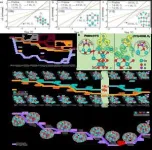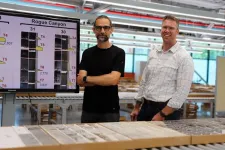(Press-News.org) A new applied mathematical theory could enhance our understanding of how sea ice affects global climate, potentially improving the accuracy of climate predictions.
The authors of a new paper published in the Proceedings of the Royal Society A on 28 August, offer new insights into how heat travels through sea ice, a crucial factor in regulating Earth's polar climate.
Dr Noa Kraitzman, Senior Lecturer in Applied Mathematics at Macquarie University and lead author of the study, says the research addresses a key gap in current climate modelling.
“Sea ice covers about 15 per cent of the ocean’s surface during the coldest season when it's at its vast majority,” Dr Kraitzman says. “It’s a thin layer that separates the atmosphere and the ocean and is responsible for heat transfer between the two.”
Sea ice acts as an insulating blanket on the ocean, reflecting sunlight and moderating heat exchange. As global temperatures rise, understanding how sea ice behaves will become increasingly important for predicting climate change.
The study focuses on the thermal conductivity of sea ice, a critical parameter used in many global climate models. The movement of liquid brine within sea ice, which can potentially increase its heat transport, was not accounted for in previous models.
Dr Kraitzman says the unique structure of sea ice, along with its sensitive dependence on temperature and salinity, means it is challenging to measure and predict its properties, specifically its thermal conductivity.
“When you look at sea ice on a small scale, what makes it interesting is its complex structure because it’s made up of ice, air bubbles, and brine inclusions.
“As the atmosphere above the ocean becomes extremely cold, below minus 30 degrees Celsius, while the ocean water remains at about minus two degrees, this creates a large temperature difference, and the water freezes from the top down.
“As the water freezes rapidly, it pushes out the salt, creating an ice matrix of purely frozen water which captures air bubbles and pockets of very salty water, called brine inclusions, surrounded by nearly pure ice.”
These dense brine inclusions are heavier than the fresh ocean water which results in convective flow within the ice, creating big ‘chimneys’ where liquid salt flows out.
The research builds on earlier field work by Trodahl in 1999, which first suggested that fluid flow within sea ice might enhance its thermal conductivity. Dr Kraitzman’s team has now provided mathematical proof of this phenomenon.
“Our mathematics definitely shows that such an enhancement should be expected once convective flow within the sea ice begins,” Dr Kraitzman says.
The model also offers a way to relate the sea ice’s thermal properties to its temperature and salt content, allowing theoretical results to be compared with measurements.
Specifically, it provides a tool to be used in large-scale climate models, potentially leading to more accurate predictions of future conditions in the polar regions.
Sea ice in the Arctic has been declining rapidly in recent decades. This loss of ice can lead to a feedback loop: as more dark ocean water is exposed, it absorbs more sunlight, leading to further warming and ice loss.
The loss of sea ice can affect weather patterns, ocean circulation, and marine ecosystems far beyond the polar regions.
Dr Kraitzman says understanding the thermal conductivity of sea ice is important for predicting its future.
The researchers note that while their model provides a theoretical framework, more experimental work is needed to integrate these findings into large-scale climate models.
The study was conducted by mathematicians from Macquarie University in Australia, the University of Utah and Dartmouth College, New Hampshire in the USA.
It was supported by funding from the US National Science Foundation.
END
Cold math, hot topic: Sea ice thermal conductivity
Mathematicians crack a sea ice puzzle that could reshape climate models
2024-08-28
ELSE PRESS RELEASES FROM THIS DATE:
Individuals with type 2 diabetes who are at higher risk of certain cancers could be identified by a simple blood test, Danish study suggests
2024-08-28
Individuals with type 2 diabetes who are at higher risk of certain cancers could be identified by a simple blood test, this year’s Annual Meeting of the European Association for the Study of Diabetes (EASD) (Madrid, 9-13 September) will hear.
People with type 2 diabetes are known to be at higher risk of developing cancers associated with obesity (OR cancers), including breast, kidney, womb, thyroid and ovarian cancer, as well as gastrointestinal cancers, including colorectal and pancreatic ...
New UT School of Public Health San Antonio welcomes inaugural class, launches degree program designed for South Texas
2024-08-27
The University of Texas School of Public Health San Antonio (UT School of Public Health San Antonio), a collaboration between The University of Texas Health Science Center at San Antonio (UT Health San Antonio) and The University of Texas at San Antonio (UTSA), proudly welcomes its inaugural class and the official launch of the region’s first Master of Public Health (MPH) graduate degree program.
Beginning Monday, Aug. 26, the first cohort of 40 students will attended classes at the new UT School of Public Health San Antonio, located on the Greehey Campus at UT Health San Antonio. Many of the students in the program ...
Mizzou researchers explore solutions to help reduce nurse burnout
2024-08-27
COLUMBIA, Mo. -- Even before the coronavirus pandemic, high rates of burnout and staffing shortages plagued the nursing industry, primarily because of the stressful demands of the job. The COVID-19 pandemic only amplified these challenges, and with nearly a third of all Missouri nurses nearing retirement, improving nurse retention is key to avoiding an impending nursing workforce crisis in our state.
Despite dozens of studies proving burnout is an issue, few provide interventions to help nurses — and their patients — overcome its challenges.
A recent study by the University of Missouri has found that ...
Algorithm raises new questions about Cascadia earthquake record
2024-08-27
The Cascadia subduction zone in the Pacific Northwest has a history of producing powerful and destructive earthquakes that have sunk forests and spawned tsunamis that reached all the way to the shores of Japan.
The most recent great earthquake was in 1700. But it probably won’t be the last. And the area that stands to be affected is now bustling metropolises that are home to millions of people.
Figuring out the frequency of earthquakes – and when the next “big one” will happen – is an active scientific question that involves looking for signs of past earthquakes in the geologic record in the form of shaken up rocks, ...
Defining chronic pain for high-performance athletes with disabilities
2024-08-27
With the Paris 2024 Paralympic Games just around the corner, the extensive training and the sacrifices athletes make to compete at the games take centre stage.
For Paralympians and high-performance athletes with spinal cord injuries (SCI), assessing chronic pain plays a key role in their training and readiness to compete. However, the source of chronic pain is often misattributed to acute trauma or overuse injuries. While the International Olympic Committee acknowledges pain management data among Paralympians and athletes with disabilities is limited, few studies have been launched investigating this dilemma.
Now, new research from UBC Okanagan highlights the need for more comprehensive ...
Illinois researchers develop near-infrared spectroscopy models to analyze corn kernels, biomass
2024-08-27
URBANA, Ill. – In the agricultural and food industry, determining the chemical composition of raw materials is important for production efficiency, application, and price. Traditional laboratory testing is time-consuming, complicated, and expensive. New research from the University of Illinois Urbana-Champaign demonstrates that near-infrared (NIR) spectroscopy and machine learning can provide quick, accurate, and cost-effective product analysis.
In two studies, the researchers explore the use of NIR spectroscopy for analyzing characteristics of corn kernels and sorghum biomass.
“NIR spectroscopy has many advantages over traditional methods. ...
It’s the most common STI you’ve never heard of. Will this newly developed drug provide the cure?
2024-08-27
Researchers at Tulane University are leading a groundbreaking study to seek a more effective treatment for trichomoniasis, an infection that, despite being the most common curable sexually transmitted infection (STI) worldwide, continues to fly under the radar.
The five-year, multi-center study is funded by a $9.2 million National Institutes of Health grant and will compare the effectiveness of a recently approved medication, secnidazole, against the current standard treatment, metronidazole, using ...
Texas A&M researchers find that aoudad, bighorn sheep share respiratory pathogens
2024-08-27
By Courtney Price, Texas A&M College of Veterinary Medicine and Biomedical Sciences
A team of researchers at the Texas A&M College of Veterinary Medicine and Biomedical Sciences (VMBS) has discovered that aoudad — an animal in the sheep and goat family — can catch and spread many of the same respiratory pathogens that can impact desert bighorn sheep, a native species in Texas that often shares its habitat with aoudad.
The new research, recently published in the journal PLOS ONE, will help wildlife conservationists better understand the complex relationship between ...
CRF announces TCT 2024 late-breaking clinical trials and science
2024-08-27
NEW YORK – August 27, 2024 – The Cardiovascular Research Foundation® (CRF®) is pleased to announce the late-breaking clinical trials and science to be featured at TCT® 2024. As the annual scientific symposium of CRF® and the world’s premier educational meeting specializing in interventional cardiovascular medicine, TCT® 2024 will be held October 27-30 in Washington, D.C. at the Walter E. Washington Convention Center.
For over three decades, TCT® has been at the forefront of innovation, education, and collaboration in interventional ...
Not sure how to stand out as a leader on Zoom calls? It starts with how you communicate, new study shows
2024-08-27
BINGHAMTON, N.Y. -- More companies are embracing remote work, and with that comes a need for more frequent communication. Teamwork through a screen isn’t always the same as having a group in the same room, so how are companies cultivating leaders in these virtual settings?
New research involving a collaboration between Binghamton University, State University of New York schools and research centers shows how, in virtual teams where nonverbal cues are limited, a person’s engagement and influence in conversations can significantly shape whether they’re perceived as a leader.
But taking charge of the conversation isn’t enough, the study found; for leadership ...
LAST 30 PRESS RELEASES:
An ‘illuminating’ design sheds light on cholesterol
Who is more likely to get long COVID?
Study showcases resilience and rapid growth of “living rocks”
Naval Research Lab diver earns Office of Naval Research 2025 Sailor of the Year
New Mayo-led study establishes practical definition for rapidly progressive dementia
Fossil fuel industry’s “climate false solutions” reinforce its power and aggravate environmental injustice
Researchers reveal bias in a widely used measure of algorithm performance
Alcohol causes cancer. A study from IOCB Prague confirms damage to DNA and shows how cells defend against it
Hidden viruses in wastewater treatment may shape public health risks, study finds
Unlock the power of nature: how biomass can transform climate mitigation
Biochar reshapes hidden soil microbes that capture carbon dioxide in farmland
Reducing saturated fat intake shows mortality benefit, but only in high-risk individuals
Manta rays create mobile ecosystems, study finds
Study: Mixed results in using lipoic acid to treat progressive multiple sclerosis
Norbert Holtkamp appointed director of Fermi National Accelerator Laboratory
New agentic AI platform accelerates advanced optics design
Biologists discover neurons use physical signals — not electricity — to stabilize communication
Researchers discover that a hormone can access the brain by hitchhiking
University of Oklahoma researcher awarded funding to pursue AI-powered material design
Exploring how the visual system recovers following injury
Support for parents with infants at pediatric check-ups leads to better reading and math skills in elementary school
Kids’ behavioral health is a growing share of family health costs
Day & night: Cancer disrupts the brain’s natural rhythm
COVID-19 vaccination significantly reduces risk to pregnant women and baby
The role of vaccination in maternal and perinatal outcomes associated with COVID-19 in pregnancy
Mayo Clinic smartwatch system helps parents shorten and defuse children's severe tantrums early
Behavioral health spending spikes to 40% of all children’s health expenditures, nearly doubling in a decade
Digital cognitive behavioral treatment for generalized anxiety disorder
Expenditures for pediatric behavioral health care over time and estimated family financial burden
Air conditioning in nursing homes and mortality during extreme heat
[Press-News.org] Cold math, hot topic: Sea ice thermal conductivityMathematicians crack a sea ice puzzle that could reshape climate models







